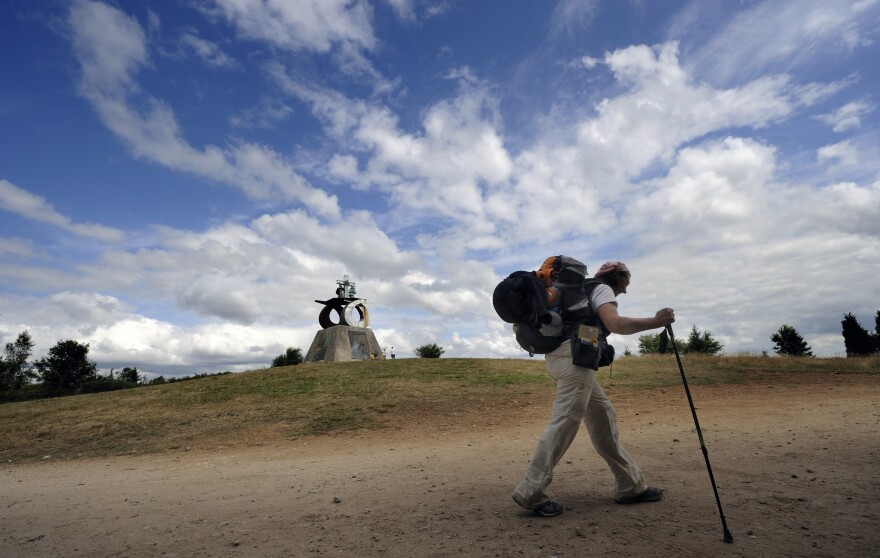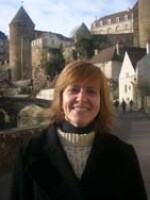A 1,200-year old European pilgrimage route is experiencing a revival. Last year alone, some 200,000 followed in the footsteps of their medieval forebears on the Way of St. James, making their way some 750 miles from Paris across France to the Spanish coastal city of Santiago de Compostela, and the relics of the eponymous apostle.
But now, what was once a strictly religious affair has become a cultural and social phenomenon that attracts the nonreligious as well. The journey was captured in The Way, a 2010 film made by father-and-son duo Martin Sheen and Emilio Estevez.

For centuries, pilgrims crossed France into Spain on one of four major routes, depending on whether they were coming from the north, east or south from Italy. American writer David Downie began his recent pilgrimage as many did in medieval times, at the Tour St. Jacques in downtown Paris.
"This was where thousands and thousands of pilgrims would meet and start off to walk all the way down to Spain to Santiago de Compostela," Downie says. "This was like 'Pilgrimage Central' in Paris."
Downie has just written a book about his 3-month trek entitled Paris to the Pyrenees: A Skeptic Pilgrim Walks the Way of Saint James. In the past, he says, pilgrims went to St. Jacques de Compostelle, as it is known in French, to pray for their sins or for others. The rich even hired pilgrims to carry messages for them.
As we make our way across Paris along the traditional pilgrims' route on ancient Roman roads, we have to dodge a lot of traffic. But Downie assures me pilgrims of yore had it much harder.
"I think it's difficult for us to imagine just how dangerous it was, how horrible. Think of the footwear they had. Think of the fact that there was often nowhere to get clean water, or anywhere to eat," Downie says. "There were brigands and murderers lurking. A lot of these people who went off on a pilgrimage had no idea whether they'd make it back."
The pilgrimage to Santiago de Compostela started in the 9th century when the martyred St. James' bones are said to have arrived in a boat to the rocky Galician coast; it fell out of fashion around the time of the French revolution. It began to regain popularity in the 1960s when a French university scholar wrote about it.
Over the past decades its popularity has soared. In 1982 there were 120 pilgrims. Last year there were nearly 200,000 pilgrims, mostly from Europe.

The Burgundy town of Vezelay, whose church is said to hold Mary Magdalene's bones, is on another French pilgrimage route. Buried in the cobbled streets are brass plaques of scallops, the symbol of St. James.
Paris shopkeeper Catherine Sauger wears a scallop shell on her backpack. She's doing a 2-week leg of the route and will pick it back up again on her August vacation.
She says it's a wonderful way to discover the gastronomy and regions of France. And walking on a pilgrimage, she says, gives you strength at every level.
For many Catholics, the pilgrimage to Compostela is a profound religious experience. But many pilgrims do it for nonreligious reasons, and the walk to Compostela has morphed into a social and cultural phenomenon. Pilgrims stay in special hostels and many carry cards that are stamped to show their progress along the route.
Leaving Vezelay, I spot a lone backpacker on a busy road.
Pascal Begin, a 55-year-old parish priest, has taken off his shoes and socks to reveal bandages all over his feet — and he's only been walking for a day.
"I always wanted to do this pilgrimage for the adventure and spiritual growth," he says. "But whether you're religious or not, everyone is looking for simplicity and getting to know themselves and meeting others. It's just human."
Standing where the Paris beltway now cuts through the pilgrims' route, author David Downie muses about what he took away from months of walking in the sun, rain and snow. He didn't have a religious epiphany, he says, but it did change his way of looking at things.
"You get a very different idea of what it means to be out in the elements, and distances, too. When you drive, you have no idea what distances have meant to humans for, well, since the beginning right?" he says. "Most people walked everywhere. And if you wanted to cover a thousand miles, you had to walk."
Copyright 2021 NPR. To see more, visit https://www.npr.org. 9(MDAxNzg0MDExMDEyMTYyMjc1MDE3NGVmMw004))




